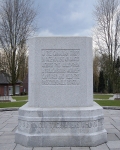Passchendaele Memorial
Archaeology »
Archaeological Monuments » Passchendaele Memorial
Passchendaele Memorial - Belgium
Passchendaele Memorial is located in Passendale.
Passchendaele Memorial monument was established on 1917.
Primary threats to Passchendaele Memorial :
The memorial is located on the former site of Crest Farm, an objective captured by the 4th Canadian Division during the assault of 30 October 1917.
Historical facts of Passchendaele Memorial :
- The Passchendaele Memorial monument, also known as the Canadian National Vimy Memorial, was established in 1917 to commemorate the significant events that took place during the Battle of Passchendaele in World War I. This monumental structure stands as a tribute to the thousands of Canadian soldiers who fought and lost their lives in one of the most brutal and devastating battles of the war.
- The Battle of Passchendaele, also known as the Third Battle of Ypres, took place from July to November 1917 in the region of Flanders, Belgium. It was characterized by its ferocious fighting conditions, as heavy rainfall turned the battlefield into a muddy quagmire. The objective of the battle was to capture the village of Passchendaele, which was a strategically important position for the Allied forces.
- The battle was fought primarily by British, Australian, New Zealand, and Canadian soldiers. The Canadian Corps, under the command of General Sir Arthur Currie, played a vital role in the later stages of the battle. They faced immense challenges as they advanced through the waterlogged and shell-torn landscape, enduring relentless enemy fire and the treacherous conditions underfoot.
- The Passchendaele Memorial was designed by Canadian sculptor and architect Walter Seymour Allward. It is situated on the former battlefield near the village of Vimy in the Ypres Salient, where the battle took place. The monument is a towering structure, reaching a height of approximately 30 meters (100 feet). It consists of two large stone pylons with allegorical sculptures representing Canada mourning its fallen soldiers.
- The memorial's central feature is the statue of a grieving woman, known as "Canada Bereft." She stands atop a granite pedestal, looking down towards the open grave of a fallen soldier. The figure is symbolic of the nation's collective mourning and loss during the war. The inscription on the base of the statue reads, "To the valour of their countrymen in the Great War and in memory of their sixty thousand dead this monument is raised by the people of Canada."
- The Passchendaele Memorial was unveiled on July 26, 1936, in the presence of King Edward VIII. It serves as a lasting reminder of the sacrifices made by Canadian soldiers during the battle and the war as a whole. The monument is not only a tribute to those who perished but also a symbol of national unity and pride.
- Today, the Passchendaele Memorial continues to attract visitors from around the world who come to pay their respects and reflect upon the profound impact of World War I. The surrounding area has been transformed into a memorial park, with landscaped gardens and pathways that provide a serene and contemplative atmosphere.
- The historical significance of the Passchendaele Memorial cannot be overstated. It stands as a testament to the horrors of war and the bravery of those who fought and died. It serves as a reminder of the importance of remembrance, ensuring that the sacrifices made by previous generations are never forgotten. The Passchendaele Memorial stands tall, honoring the memory of the fallen and serving as a symbol of hope, peace, and reconciliation.

